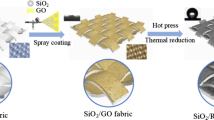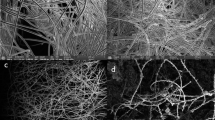Abstract
In this work, graphene/Ag (GA/Ag) composite aerogels with the micro rough porous structure and conductive property and polydimethylsiloxane(PDMS) with the low surface energy were used to prepare super-hydrophobic cotton fabric (GA/Ag/PDMS@cotton) with conductive property was successfully prepared. The surface morphologies, chemical composition, wettability, conductive property and microwave absorption property of GA/Ag/PDMS@cotton fabric were characterized. It was shown that GA/Ag and PDMS were successfully coated onto the surface of cotton fabrics. The water contact angle of GA/Ag/PDMS@cotton was 157°. And it could make the luminous diode shining continuously. The treated cotton fabrics exhibited excellent super-hydrophobic and conductive properties. The minimum reflection loss of GA/Ag/PDMS@cotton fabric was − 28 dB, and it had a larger effective absorption bandwidth. In addition, the treated cotton fabric also showed excellent anti-fouling and self-cleaning properties. The GA/Ag/PDMS@cotton fabric cannot be wetted and polluted by water, fruit juice, milk and black tea. And it also had excellent washing durability, acid and alkali corrosion and storage stability.













Similar content being viewed by others
References
K. Qian, Z. Yao, H. Lin et al., The influence of Nd substitution in Ni–Zn ferrites for the improved microwave absorption properties. Ceram. Int. 46(1), 227–235 (2019)
J.L. Pan, R.J. Zhang, J. Ling et al., Controllable preparation and microwave absorption properties of shape anisotropic Fe3O4 nanobelts. J. Materiomics (2021). https://doi.org/10.1016/j-jmat.2021.03.009
P. Chen, L.W. Jiang, S.S. Yang et al., Facile synthesis and microwave-absorption properties of organic-inorganic CoFeO/Polyaniline nanocomposites with embedded structure. J. Nanosci. Nanotechnol. 20(3), 1756–1764 (2020)
M.A. Kazakova, N.V. Semikolenova, E.Y. Korovin et al., Co/multi-walled carbon nanotubes/polyethylene composites for microwave absorption: tuning the effectiveness of electromagnetic shielding by varying the components ratio. Compos. Sci. Technol. (2021). https://doi.org/10.1016/J.COMPSCITECH.2021.108731
C.B. Ge, G.L. Wang, G.Q. Zhao et al., Lightweight and flexible poly (ether-block-amide)/ multiwalled carbon nanotube composites with porous structure and segregated conductive networks for electromagnetic shielding applications. Compos. A (2021). https://doi.org/10.1016/J.COMPOSITESA.2021.106356
M.M. Jiang, Y. Ding, L.H. Xu et al., Application of graphene in electrical resistance electromagnetic shielding fabric. J. Phys. Conf. Ser. (2021). https://doi.org/10.1088/1742-6596/1790/1/012079
M. Mohseni, H.S. Far, M. Hasanzadeh et al., Non-fluorinated sprayable fabric finish for durable and comfortable super-hydrophobic textiles. Prog. Org. Coat. 157, 42–46 (2021)
K.K. Kazemi, T. Zarifi, M. Mohseni et al., Smart super-hydrophobic textiles utilizing a long-range antenna sensor for hazardous aqueous droplet detection plus prevention. ACS Appl. Mater. Interfaces. (2021). https://doi.org/10.1021/ACSAMI.1C07880
H.K. Peng, Y.T. Wang, T.T. Li et al., Super-hydrophobic/flame retardant/emi shielding fabrics: manufacturing techniques and property evaluations. Appl. Sci. 9(9), 1914 (2019)
J.F. Gao, L. Wang, Z. Guo et al., Flexible, super-hydrophobic, and electrically conductive polymer nanofiber composite for multifunctional sensing applications. Chem. Eng. J. 381(381), 493–502 (2020)
M. Abraham, K. Svetlana, Super-hydrophobic surfaces: methodological considerations for physical design. J. Colloid Interface Sci. 568(568), 148–154 (2020)
S.H. Li, J.Y. Huang, Z. Chen et al., Review on special wettability textiles: theoretical models, fabrication technologies and multifunctional applications. J. Mater. Chem. A 5(1), 31–55 (2017)
L. Wang, S. Zhang, A. Ambrosi, 3D-graphene for electrocatalysis of oxygen reduction: increasing number of layers increases the catalytic effect. Electrochem. commun. 46, 148–151 (2014)
Y.X. Xu, K.X. Sheng, C. Li et al., Self-assembled graphene hydrogel via a one-stephydrothermal process. ACS Nano. 4(7), 4324–4330 (2010)
W. Chen, L. Yan, In situ self-assembly of mild chemical reduction graphene for three-dimensional architectures. Nanoscale 3(8), 1–5 (2011)
C. Zhu, S. Dong, Recent process in graphene-based nanomaterials as advanced electrocatalysts towards oxygen reduction reaction. Nanoscale 5(5), 1753–1767 (2013)
Y. Qin, C.L. Xue, H.R. Yu et al., The construction of bio-inspired hierarchically porous graphene aerogel for efficiently organic pollutants absorption. J. Hazard. Mater. (2021). https://doi.org/10.1016/J.JHAZMAT.2021.126441
J.H. Yin, D. Gao, X.M. Zhu et al., One-pot synthesis of 3D porous Bi7O9I3/N-doped graphene aerogel with enhanced photocatalytic activity for organic dye degradation in wastewater. Ceram. Int. (2021). https://doi.org/10.1016/J.CERAMINT.2021.03.293
L.J. Zou, X. Xiao, C.H. Chu et al., Facile synthesis of porous CoFe2O4/graphene aerogel for catalyzing efficient removal of organic pollutants. Sci. Total Environ. (2021). https://doi.org/10.1016/J.SCITOTENV.2020.143398
Z.C. Chen, T.L. Chang, C.H. Chen et al., Flexible NO gas sensor fabricated using graphene/silver nanoparticles stacked electrode structures. Mater. Lett. (2021). https://doi.org/10.1016/J.MATLET
C.R. Guo, Y.X. Li, Y.P. Zhu et al., Synthesis and characterization of free-stand graphene/silver nanowire/graphene nano composite as transparent conductive film with enhanced stiffness. Appl. Sci. (2020). https://doi.org/10.3390/app10144802
W.X. Zhang, W. Song, J.M. Huang et al., Graphene:silver nanowire composite transparent electrode based flexible organic solar cells with 13.4% efficiency. J. Mater. Chem. A (2019). https://doi.org/10.1039/C9TA07493G
G. Shi, T.Q. Liu, Z. Kopecki et al., A Multifunctional Wearable Device with a Graphene/Silver Nanowire Nanocomposite for Highly Sensitive Strain Sensing and Drug Delivery. C (2019). https://doi.org/10.3390/c5020017
L.Z. Zheng, X.J. Su, X.J. Lai et al., Conductive super-hydrophobic cotton fabrics via layer-by-layer assembly of carbon nanotubes for oil-water separation and human motion detection[J]. Mater. Lett. 253, 230–233 (2019)
X.F. Liao, H.Q. Li, X.J. Lai et al., Facile fabrication of super-hydrophobic conductive polydimethylsiloxane@silver nanowires cotton fabric via dipping-thermal curing method[J]. Mater. Lett. 255, 37–49 (2019)
M. Ashraf, C. Campagne, A. Perwuelz, P. Champagne et al., Development of superhydrophilic and superhydrophobic polyester fabric by growing Zinc Oxide nanorods. J. Colloid Interface Sci. 255, 37–49 (2019)
Acknowledgements
This work was financially supported by Shanghai Natural Science Foundation (Grant No. 21ZR426200); National Natural Science Foundation of China (Grant No. 51703123).
Author information
Authors and Affiliations
Corresponding author
Additional information
Publisher's Note
Springer Nature remains neutral with regard to jurisdictional claims in published maps and institutional affiliations.
Rights and permissions
Springer Nature or its licensor holds exclusive rights to this article under a publishing agreement with the author(s) or other rightsholder(s); author self-archiving of the accepted manuscript version of this article is solely governed by the terms of such publishing agreement and applicable law.
About this article
Cite this article
Liu, Y., Xu, L., Pan, H. et al. Preparation of super-hydrophobic cotton fabrics with conductive property based on graphene/Ag composite aerogels. J Porous Mater 29, 2019–2030 (2022). https://doi.org/10.1007/s10934-022-01311-4
Accepted:
Published:
Issue Date:
DOI: https://doi.org/10.1007/s10934-022-01311-4




